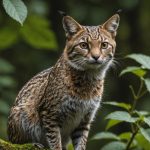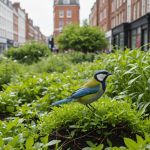Overview of Urban Greening and Bird Diversity
Urban greening encompasses a variety of practices designed to increase vegetation in city environments, such as creating urban parks, implementing green roofs, and developing community gardens. These efforts aim to enhance biodiversity, regulate temperatures, and improve air quality.
One key focus of urban greening is the promotion of bird diversity. Birds play vital roles in urban ecosystems, acting as pollinators, pest controllers, and indicators of environmental health. Preserving a variety of bird species within urban areas is essential for maintaining ecological balance, as diverse bird populations contribute to the resilience of these ecosystems.
In the same genre : Protecting native wildlife: the role of uk traffic laws in reducing roadkill
Recent studies have highlighted the positive correlation between urban greening and increased biodiversity. For example, research demonstrates that areas with more green spaces tend to support a higher variety of bird species. These findings emphasize the ecological benefits of increasing vegetation in cities.
Urban planners and policymakers are increasingly encouraged to incorporate ecological benefits into their development projects. By prioritizing urban greening, cities can create more interconnected habitats, supporting both human and wildlife communities and fostering a sustainable urban future. Understanding these dynamics allows for well-informed decisions that address both environmental and societal needs.
Topic to read : Nurturing nature: practical strategies for uk communities to safeguard local orchid species
Case Studies of Urban Greening Initiatives in UK Cities
In the UK, urban greening initiatives have showcased significant contributions to enhancing urban environments. Such projects frequently revolve around the development of urban parks and the installation of green roofs. These undertakings not only revitalise city landscapes but also encourage bird diversity, thus promoting ecological benefits.
Example of Park Development
A notable project is the Queen Elizabeth Olympic Park in London. Originally developed for the 2012 Olympics, it has become a thriving urban park. This park has fostered increased diversity among local bird species by providing varied habitats such as wetlands and grassy expanses. Community engagement is integral here; initiatives include bird-watching tours and educational workshops focusing on ecological benefits.
Implementation of Green Roofs
Prominent examples of green roofs include the extensive installations atop London’s Cannon Street Station and Sheffield’s University buildings. These roofs significantly impact urban microclimates by decreasing heat and providing new habitats for birds. Their long-term sustainability is ensured through efficient maintenance practices, contributing to both energy savings and bird diversity.
Policy Frameworks Supporting Urban Greening
Government frameworks, like the UK’s Green Infrastructure Strategy, bolster urban greening. These policies facilitate collaboration between municipalities and environmental organisations, enhancing community involvement and ensuring the realisation of urban greening’s full potential.
Data on Bird Diversity in Urban Settings
In understanding urban ecosystems, bird population statistics are vital. Tracking these dynamics allows for insights into how urban greening initiatives impact avian life. Surveys have consistently demonstrated a richness in bird diversity in areas with substantial vegetation compared to non-green environments. This correlation highlights the transformative potential of urban greening efforts on local ecosystems.
Citizen science plays an integral role in this endeavour. Volunteers contribute to data collection, offering valuable information that assists researchers and urban planners alike. By engaging the community in these efforts, the data becomes more extensive and reflects local nuances with higher accuracy.
Studies comparing green to non-green urban spaces consistently reveal higher species variety where vegetation is abundant. This variety not only supports ecological resilience but also provides indirect benefits to city inhabitants, such as pest control and enhanced mental well-being. The integration of citizen science ensures that diverse voices contribute to understanding and optimizing urban biodiversity.
Overall, the data underscores the necessity of targeted urban planning to sustain and promote bird diversity. Comprehensive analysing of population statistics and ongoing community involvement are key to successfully maintaining ecological balance within urban settings.
Benefits of Urban Greening for Bird Populations
Urban greening significantly contributes to enhancing ecological benefits and promoting species richness by creating interconnected habitats. Such habitats are crucial in fragmented urban settings, providing refuges and resources for diverse bird populations. Through green spaces, cities can foster habitat connectivity, enabling birds to thrive in previously inhospitable environments. This connectivity is not only ecologically beneficial but also enhances biodiversity.
Increased species richness is a notable outcome of urban greening. Diverse environments attract a variety of bird species, each playing distinct roles in the ecosystem, such as pollination and pest control. These roles are vital for maintaining ecological balance, supporting plant reproduction and controlling insect populations, which helps sustain healthy urban ecosystems.
Beyond ecological benefits, urban greening offers psychological and recreational advantages for residents. Green spaces contribute to mental well-being by providing environments where people can unwind, observe nature, and engage in bird-watching activities. These spaces also encourage community interaction and educational opportunities, fostering a sense of stewardship among urban dwellers.
Ultimately, the integration of urban greening practices enhances both human and avian quality of life, proving its paramount significance in urban planning and development.
Recommendations for Urban Planners and Policymakers
Understanding the intricate relationship between urban planning and biodiversity strategies is crucial for fostering ecological resilience in cities. Urban planners should prioritise integrating green spaces into cityscapes as a fundamental aspect of sustainable development. These spaces provide vital refuges and resources for wildlife, contributing to increased species richness and ecological benefits.
A key strategy involves collaborating with local communities to enhance planning processes. Engaging residents in decision-making ensures that urban greening efforts align with their needs and values. It fosters a sense of stewardship, encouraging citizens to participate in maintaining and supporting green initiatives.
Furthermore, continuous research is imperative to inform future policy initiatives. Policymakers should support studies on the long-term impact of urban greening on biodiversity and the quality of urban life. This allows for evidence-based decisions that promote ecological and social well-being.
To optimise the benefits of urban greening, policymakers should work alongside environmental organisations, facilitating resource-sharing and expertise. By adopting comprehensive and inclusive strategies, urban planners and policymakers can ensure cities are vibrant ecosystems where nature and humanity coexist harmoniously.















